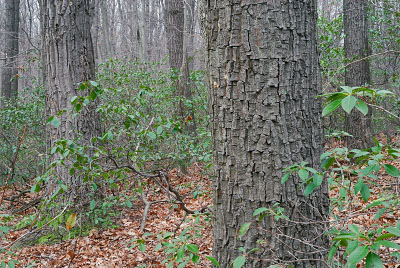
 Departamento de Conservación y Recreación (DCR)
Departamento de Conservación y Recreación (DCR) Conservar. Proteger. Disfrutar.
 Departamento de Conservación y Recreación (DCR)
Departamento de Conservación y Recreación (DCR)  Tabla de contenidos
Tabla de contenidosBosques de robles / brezales
This group of oak-dominated forests is prevalent on xeric, infertile upland sites in every physiographic province of Virginia, and is wide-ranging in the Appalachians and adjacent provinces outside of the Commonwealth. In some cases, particularly in the mountains and foothills, these communities have replaced former mixed oak - American chestnut (Castanea dentata) forests following the decimation of chestnut overstory trees by an introduced fungal blight (Cryphonectria parasitica) early in the twentieth century. Habitats are variable, ranging from sterile, low-elevation "flatwoods" to steep, rocky mountainsides. All have soils with a distinctly oligotrophic nutrient regime, i.e., strongly acidic, with low base cation levels and relatively high levels of iron. Accumulations of thick duff and high biomass of inflammable shrubs in these forests make them susceptible to periodic fires, which in turn favors recruitment of oaks. Regionally varying mixtures of white oak (Quercus alba), chestnut oak (Quercus montana), scarlet oak (Quercus coccinea), black oak (Quercus velutina), northern red oak (Quercus rubra), southern red oak (Quercus falcata), and post oak (Quercus stellata) compose the overstories of these forests. Bigtooth aspen (Populus grandidentata) and pines - including pitch pine (Pinus rigida) in the mountains, shortleaf and Virginia pines (Pinus echinata and Pinus virginiana) in the Piedmont, and loblolly pine (Pinus taeda) in the Coastal Plain - are common associates that usually indicate past disturbance. Hickories (Carya spp.) are generally unimportant and, when present, mostly restricted to the understory.

Forests overwhelmingly dominated by chestnut oak (Quercus montana, = Quercus prinus) are widespread on sandstone or quartzite ridges in the mountains, but occur locally on monadnocks, foothills, and rocky or gravelly bluffs throughout the Piedmont and inner Coastal Plain. On gentler, low-elevation terrain of eastern Virginia and the mountain valleys, white oak is more prominent in mixtures with several other oaks. Blackgum (Nyssa sylvatica) and sourwood (Oxydendrum arboreum) are frequent overstory associates and abundant understory trees, along with sassafras (Sassafras albidum) and downy serviceberry (Amelanchier arborea). Decades of fire suppression or exclusion has led to a general abundance of the fire-intolerant red maple (Acer rubrum) in oak / heath forest understories. Ericaceous (heath-family) plants, including mountain laurel (Kalmia latifolia), black huckleberry (Gaylussacia baccata), wild azalea (Rhododendron periclymenoides), and blueberries (Vaccinium spp.), form dense colonies in the shrub and herb layers. Evergreen rhododendrons (Rhododendron maximum and Rhododendron catawbiense) and flame azalea (Rhododendron calendulaceum) are locally prevalent members of the ericaceous shrub complex in the mountains, while dangleberry (Gaylussacia frondosa) is a prominent ericad in the Coastal Plain. The ericaceous sub-shrubs trailing arbutus (Epigaea repens) and wintergreen (Gaultheria procumbens) may also be abundant, especially in the mountains. The density of ericaceous species may be closely tied to land-use and disturbance history. True herbaceous species are sparse, but may include scattered individuals or colonies of xerophytes such as galax (Galax urceolata), yellow wild indigo (Baptisia tinctoria), pink lady's-slipper (Cypripedium acaule), dwarf iris (Iris verna), large whorled pogonia (Isotria verticillata), cancer-root (Orobanche uniflora), gaywings (Polygaloides paucifolia), eastern bracken fern (Pteridium aquilinum ssp. latiusculum), and Virginia goat's-rue (Tephrosia virginiana).
Los tipos de comunidad en este grupo constituyen un elemento generalizado de vegetación matricial o de gran parche en el paisaje de Virginia. Aunque todavía son relativamente extensas, están sujetas a múltiples perturbaciones, incluida la tala rasa, la conversión a silviculturas de plantaciones de pinos, la infestación de polillas gitanas, la supresión de incendios y la destrucción por el desarrollo. Sin embargo, varios rodales dominados por robles castaños en las crestas secas de las montañas de Virginia han escapado a la tala debido al crecimiento atrofiado y la mala forma de los árboles del sotobosque.
Referencias: Abrams et al . (1997), Adams y Stephenson (1983), Allard y Leonard (1943), Clark y Ware (1980), Cole y Ware (1997), Coulling y Rawinski (1999), Crouch (1990), Farrell y Ware (1988), Fleming (2002a), Fleming (2002b), Fleming (2007), Fleming y Coulling (2001), Fleming y Moorhead (1996), Fleming y Moorhead (2000), Fleming y Weber (2003), Gemborys (1974), Harrison et al . (1989), Johnson y Ware (1982), Martin et al . (1982), McCoy y Fleming (2000), McEvoy et al . (1980), Olson y Hupp (1986), Orwig y Abrams (1994), Rawinski et al . (1994), Rawinski y otros . (1996), Rhoades (1992), Rhoades (1995), Rhoades (2002), Stephenson (1974), Stephenson (1982a), Stephenson y Adams (1991), Stephenson y Fortney (1998), Vanderhorst (2000), Walton et al. (2001), Ware (1991).Haga clic aquí para ver más fotos de este grupo comunitario ecológico.
 © DCR-DNH, Gary P. Fleming.
© DCR-DNH, Gary P. Fleming.
Se han muestreado más de 300 parcelas de esta vegetación en Virginia (Fig. 1), y se han clasificado nueve tipos de comunidades en el curso de varios análisis regionales. La mayoría de estas unidades de nivel más fino se distinguen claramente por fuertes gradientes geográficos/altitudinales y diferencias florísticas asociadas. Sin embargo, la supuesta separación de las unidades de los "Apalaches Centrales" y los "Apalaches del Sur" es particularmente problemática en el oeste de Virginia, donde las floras de estas regiones biogeográficas a menudo se fusionan insensiblemente. Haga clic en cualquier código CEGL resaltado a continuación para ver la descripción global de USNVC proporcionada por NatureServe Explorer. 
 Descargue una hoja de cálculo de estadísticas de resumen de composición para cada uno de los tipos de comunidad que se enumeran a continuación.
Descargue una hoja de cálculo de estadísticas de resumen de composición para cada uno de los tipos de comunidad que se enumeran a continuación.
Volver al principio de la página
siguiente Grupo Ecológico anterior Grupo Ecológico
